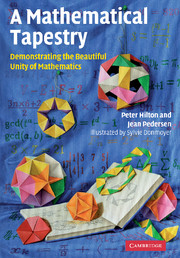Book contents
- Frontmatter
- Contents
- Preface
- Acknowledgments
- 1 Flexagons – A beginning thread
- 2 Another thread – 1-period paper-folding
- 3 More paper-folding threads – 2-period paper-folding
- 4 A number-theory thread – Folding numbers, a number trick, and some tidbits
- 5 The polyhedron thread – Building some polyhedra and defining a regular polyhedron
- 6 Constructing dipyramids and rotating rings from straight strips of triangles
- 7 Continuing the paper-folding and number-theory threads
- 8 A geometry and algebra thread – Constructing, and using, Jennifer's puzzle
- 9 A polyhedral geometry thread – Constructing braided Platonic solids and other woven polyhedra
- 10 Combinatorial and symmetry threads
- 11 Some golden threads – Constructing more dodecahedra
- 12 More combinatorial threads – Collapsoids
- 13 Group theory – The faces of the trihexaflexagon
- 14 Combinatorial and group-theoretical threads – Extended face planes of the Platonic solids
- 15 A historical thread – Involving the Euler characteristic, Descartes' total angular defect, and Pólya's dream
- 16 Tying some loose ends together – Symmetry, group theory, homologues, and the Pólya enumeration theorem
- 17 Returning to the number-theory thread – Generalized quasi-order and coach theorems
- References
- Index
9 - A polyhedral geometry thread – Constructing braided Platonic solids and other woven polyhedra
Published online by Cambridge University Press: 10 November 2010
- Frontmatter
- Contents
- Preface
- Acknowledgments
- 1 Flexagons – A beginning thread
- 2 Another thread – 1-period paper-folding
- 3 More paper-folding threads – 2-period paper-folding
- 4 A number-theory thread – Folding numbers, a number trick, and some tidbits
- 5 The polyhedron thread – Building some polyhedra and defining a regular polyhedron
- 6 Constructing dipyramids and rotating rings from straight strips of triangles
- 7 Continuing the paper-folding and number-theory threads
- 8 A geometry and algebra thread – Constructing, and using, Jennifer's puzzle
- 9 A polyhedral geometry thread – Constructing braided Platonic solids and other woven polyhedra
- 10 Combinatorial and symmetry threads
- 11 Some golden threads – Constructing more dodecahedra
- 12 More combinatorial threads – Collapsoids
- 13 Group theory – The faces of the trihexaflexagon
- 14 Combinatorial and group-theoretical threads – Extended face planes of the Platonic solids
- 15 A historical thread – Involving the Euler characteristic, Descartes' total angular defect, and Pólya's dream
- 16 Tying some loose ends together – Symmetry, group theory, homologues, and the Pólya enumeration theorem
- 17 Returning to the number-theory thread – Generalized quasi-order and coach theorems
- References
- Index
Summary
A curious fact
In Chapter 8 we gave instructions for braiding tetrahedra, cubes, and octahedra. The natural question to ask is: Can we construct the other two Platonic solids by a similar braiding technique? It turns out that we can braid all five of the regular convex solids. In fact, it is easy to verify the following composite statement for the five Platonic solids.
If you make each solid from straight strips of paper fashioned into bands and if you require that all strips on the given model be identical to (or mirror images of) one another, that every edge on the completed model be covered by at least one thickness from the strips, that every face be entirely covered by the strips, and that the same total area from each strip must show on the finished model,
Then you can braid
the tetrahedron from 2 strips
the hexahedron (cube) from 3 strips
the octahedron from 4 strips
the icosahedron from 5 strips
the dodecahedron from 6 strips.
(The pattern pieces are shown in Figure 9.1.)
We don't have any general explanation for this curious fact, but we will show you how you can easily demonstrate it. This we do by providing you with instructions for constructing the required polyhedra, and once the polyhedra are constructed, you may then verify, simply by looking at them, that they satisfy the conditions of the preceding statement.
- Type
- Chapter
- Information
- A Mathematical TapestryDemonstrating the Beautiful Unity of Mathematics, pp. 123 - 144Publisher: Cambridge University PressPrint publication year: 2010



